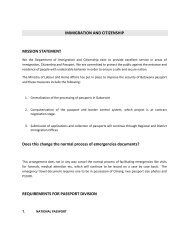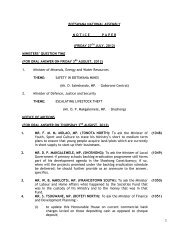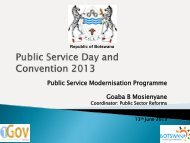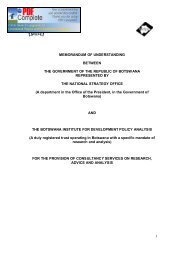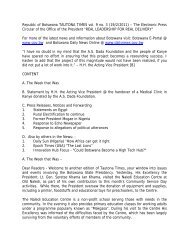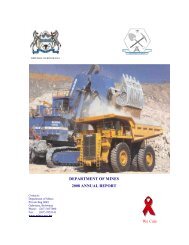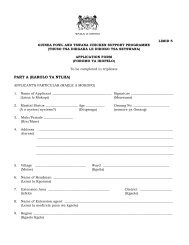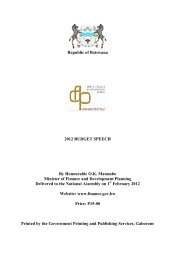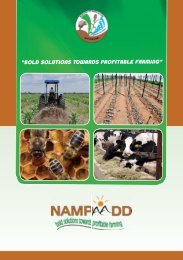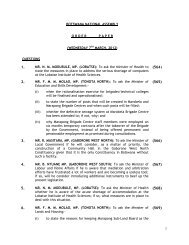Roads Department - Government of Botswana
Roads Department - Government of Botswana
Roads Department - Government of Botswana
Create successful ePaper yourself
Turn your PDF publications into a flip-book with our unique Google optimized e-Paper software.
<strong>Roads</strong> <strong>Department</strong><br />
Table 2.1 Salt content <strong>of</strong> pavement layers (Sekoma - Kang road).<br />
Average salt content % TDS (from E.C measurements)<br />
Depth,<br />
mm<br />
Edge <strong>of</strong><br />
shoulder<br />
Centre <strong>of</strong><br />
shoulder<br />
Shoulder/<br />
carriageway<br />
interface<br />
Centre <strong>of</strong><br />
carriageway<br />
0-50<br />
0.23<br />
0.38<br />
0.45<br />
0.31<br />
50-100<br />
0.18<br />
0.39<br />
0.43<br />
0.30<br />
100-150<br />
0.13<br />
0.33<br />
0.33<br />
0.28<br />
150-200<br />
0.11<br />
0.26<br />
0.28<br />
0.12<br />
200-250<br />
0.10<br />
0.19<br />
0.24<br />
0.17<br />
Remedial measures included removal <strong>of</strong> the damaged single seal and reseal <strong>of</strong><br />
the carriageway. Severely damaged sections <strong>of</strong> the shoulder were removed and<br />
reconstructed. In areas <strong>of</strong> less severe damage material in the area surrounding<br />
the dome was dug out approximately to 20 mm diameter and 50-100 mm<br />
depth) and replaced with an emulsion based premix. As shown in table 2.1, salt<br />
is still present in the pavement and it will be necessary to maintain impermeability<br />
by timely reseal in order to avoid further salt damage.<br />
The most extensive work to date on the mechanism<br />
<strong>of</strong> salt damage has been undertaken by<br />
Obika et al (1989).<br />
2.3 Salt Damage World-wide<br />
There is a paucity <strong>of</strong> published work on salt damage to bituminous pavements<br />
which probably does not reflect the scale <strong>of</strong> occurrence. The published papers<br />
deal with local environments and materials, and this has resulted in a variety<br />
<strong>of</strong> recommendations for damage prevention and repair. These recommendations<br />
have not always been used successfully in other environments, and have<br />
resulted in delays to construction or damage to the bituminous surfacing.<br />
2.3.1 India<br />
Uppal & Kapur (1957) and Mehra et al (1955) reported on the detrimental role<br />
<strong>of</strong> soluble salts on stabilised and unstabilised soils in India. In these cases the<br />
damage was due to soluble sulphate salt attack on asphaltic surfacings.<br />
2.3.2 Australia<br />
There is clear Documentation <strong>of</strong> physical salt damage to bituminous surfaced<br />
pavements in Australia (Cole & Lewis 1960). The deterioration <strong>of</strong>ten took the<br />
form <strong>of</strong> ‘fluffing’ and ‘powdering’ <strong>of</strong> sandy loam soils immediately beneath<br />
the bitumen surface. Failed and sound areas linked the deterioration to high<br />
sodium chloride (NaCl) content. This salt was believed to have migrated from<br />
a saline water table varying from 4.5 to 24 metres below surface level. Most<br />
<strong>of</strong> the salt damage in Australia is limited to high sodium chloride (NaCl) in the<br />
subgrade and construction materials.<br />
Filamentous (whisker) crystals lifting a road<br />
surfacing. In this case the whiskers are visible<br />
to the naked eye. In other cases a magnifying<br />
glass or microscope is required.<br />
Simple laboratory tests were performed on samples <strong>of</strong> soil taken from sound<br />
and failed sections <strong>of</strong> the pavement. The samples were compacted and allowed<br />
to stand under laboratory conditions. After 9 months the samples that con-<br />
14 Chapter 2<br />
Guide to the Prevention and Repair <strong>of</strong> Salt Damage to <strong>Roads</strong> and Runways<br />
Occurrence and Characteristics



